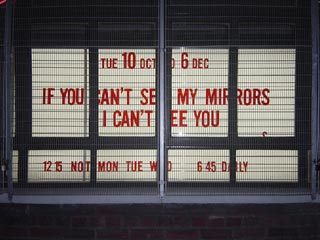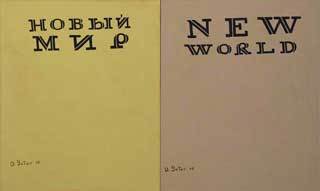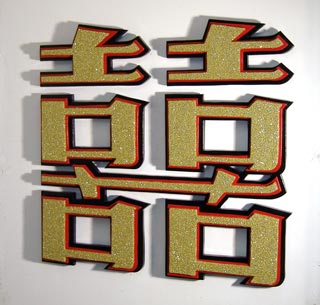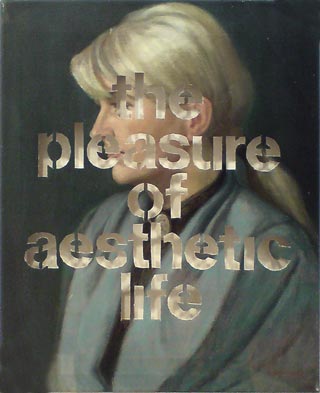
In the End was the Word
11 January - 10 February 2007
Wednesday-Friday 12-6, Saturday 12-4
Reception for the artists: Wednesday 10 January, 6-8 pm
On 11th January 2007 Matthew Bown Gallery opens In the End was the Word, a new exhibition by six artists. Four of the artists – Charlotte Cullinan and Jeanine Richards (artlab), Brian Reed, and Amikam Toren – work in London; two – Dima Gutov and Rostislav Lebedev – work in Moscow. The show runs until 10th February 2007.
In the End was the Word presents artworks which use textual elements - words, phrases, pictograms – as imagery. The exhibition examines the relationship between visual art practice and not-too-distant modes of discourse such as public signage, printed production and political slogans; it explores the interface between art and the broader popular and political culture.
Charlotte Cullinan and Jeanine Richards’s The Savage School Window Gallery Sculpture no. 1 has hitherto been visible in the window of the artists’ studio/project space at 7, Vyner Street, in East London. It consists of a large lightbox on which lettering is displayed. The lightbox has been used as a kind of blank canvas by invited artists and writers, who have created on it a range of statements/images, from the hermetic and surreal to the frankly informational The lightbox (reminiscent of the signage outside cinemas) sits on a cusp of art practice, at a point where art and beyond-art intersect: its placement – in a street-level window – suggests full public accessibility but on the other hand, Vyner Street is primarily a road of galleries and most of the work’s viewers are likely to be in search of contemporary art. Its removal, for the purposes of this show, to a West- End space, adds another twist: the re-siting of a public work in a private commercial context.
In Amikam Toren’s Armchair Paintings the creative and emotional vistas opened by de- contextualisation are apparent. A phrase of some arbitrariness is imposed, by being literally cut out of the canvas, on a kitsch painting sourced from a second-hand shop. It is tempting to seek a dialogue between the combined elements, but Toren’s transformation of the original reassuring image and meaningful phrase into an unexpected and somewhat brutal object undermines this enterprise: we are left as it were at a crossroads in unfamiliar country, hesitating between an uncertain quest for meaning and the inscrutable language of surface and edge, light and shadow.
Brian Reed’s Double Happiness is one of a series of works by the artist that deals with consumerist imagery: in this case, a Chinese kanji writ large in red, black, and gold glitter. It is an upbeat symbol commonly encountered at Chinese weddings and restaurants, but in the context of a London gallery space it has an ambiguous presence: the average viewer senses meaning, but is incapable of deciphering it, and the work’s physical presence is impressive. In a sense, it vibrates between two states: that of meaningful exhortation, grounded in an understanding of the symbol, and that of stark (if gaudy and ironic) formalism.
Dima Gutov’s New World/Novyi Mir presents two versions, Russian- and English-language, of the title of the famous communist journal. What was once a multi-lingual tool for the emancipation of the worldwide proletariat has been reprised as belle-peinture by a communist-sympathiser working in Moscow, now one of the new capitals of carnivorous capitalism. The metamorphosis of this revolutionary logo suggests the shifts to which an idealist may be put, in the 21st century, simply to get his message across.
Today New World is perhaps more likely to be understood as brand than as utopian imperative. Rostislav Lebedev’s classic work of Soviet conceptualism Made In The USSR (SDELANO V SSSR), created in the 1970s, was the first Soviet work to understand and plainly posit that Soviet iconography could be understood as an exercise in branding: a crucial step in its deconstruction. This is the first time Lebedev’s important work has been shown since the end of the Soviet Union.

The Savage School Window Gallery Sculpture no. 1
2006
Mixed media, 236 x 312 x 85 cm overall

New World/Novyi Mir
2005
Oil on canvas, 60 x 100 cm

Made In The USSR
1979
Gloss paint on masonite and chipboard, 43 x 150 x 51 cm

Double Happiness
2006
Mixed media, 89 x 93 x 6 cm

Amikam Toren
The pleasure of aesthetic life
1991
Oil on canvas, 43 x 35 cm